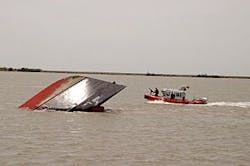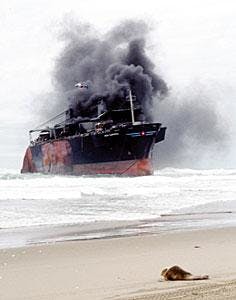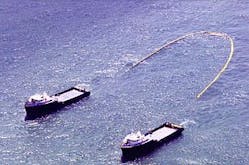While environmental protection through prevention is widely accepted as necessary and beneficial, disagreement persists over response preparedness against the continuing risk of marine oil spills. Areas of discord between oil spill response organizations (OSROs) and oil companies include capacity and readiness factors. Competent OSROs can provide quick, effective spill responses to minimize damage to the environment.
Large oil companies generally feel comfortable with overall response capability. During recent interviews, in which anonymity was guaranteed, representatives of several US oil companies insisted that they remain 100% engaged in environmental protection, regardless of reductions in the number, frequency, and size of oil spills and the focus on and redirection of capital toward new security requirements. The company representatives expressed confidence that, should a large spill happen, they would have no problem effectively responding quickly and safely to protect the environment.
The OSROs disagree. Many of them have had to expand their business scope to remain financially viable. An OSRO no longer can remain engaged solely in oil-spill clean-up response without suffering economic loss and, ultimately, financial ruin. Several OSROs are now working with clients in more expansive roles, acting in officially designated spill-response roles such as “qualified individuals” and “response supervisors” and writing response plans, operations manuals, and security plans. Spill-response companies also are beginning to offer tank-cleaning and other industrial services.
Organizations that have successfully expanded their business horizons deserve kudos. Not all OSROs have been able to do so, however. Many of them have merged with other companies or shut down. What impact does this have on the response community and overall preparedness?
Response plan
Consider this: A facility, as defined by 33 Code of Federal Regulations (CFR) Part 154, is required to develop and comply with a response plan. This plan includes, among other things, specific details on response equipment. According to 33 CFR 154.1045(c), each response plan “must identify response resources that are available, by contract or other approved means...to respond to the facility’s average most probable discharge.” This includes oil recovery devices, storage capacity, and “1,000 ft of containment boom or two times the length of the largest vessel” that regularly visits the facility to conduct transfers, whichever is greater.
The author’s inquiries indicate that most oil producers fulfill this requirement through agreements with OSROs in their areas of operation. The CFR dictates that these response assets must be able to arrive on scene within 1 hr of the detection of a spill.
If an area has five OSROs, for example, and each of them maintains 10,000 ft of boom, there is a total of 50,000 ft of boom available in the region for responses. If one company shuts down and two others merge, leaving three valid OSROs, what would happen to the extra stores of boom? There is no requirement for OSROs to have a set amount of boom in their warehouses. In fact, it is possible that the three remaining companies may not have the financial ability to acquire or maintain the extra boom. Even a financially strong OSRO typically will not repair or replace damaged boom that is in excess of classification, contract, or planning requirements. A shut-down and a merger in an area like this example thus can reduce the region’s access to crucial spill-response boom to 30,000 ft from 50,000 ft and greatly diminish response capability.
This, in fact, is happening in many areas. Why? Across the board, the cost of response, including items such as retainer fees, drill participation, and replacement of aging equipment, has increased dramatically. Also, a lack of spill-response opportunities, due to the decrease in number of spills, has reduced incomes of response organizations. To stay in business, OSROs have had to raise prices.
With responses becoming less frequent, OSROs also face diminishing experience and expertise. Drills that require equipment deployment teach mechanics and execution but fail to provide the intuition that comes from actual field work. With fewer spills, there are fewer chances to learn. And as OSROs cut full-time staff in favor of contract labor with minimal qualifications (and therefore lower wages), service degrades even further.
Company responses
Large oil producers are confident they can handle any release of oil into the environment. Royal Dutch/Shell Group, BP PLC, and Chevron Corp., for example, maintain internal response capability and use contract OSROs. In the event that a response organization was not immediately available for any reason, oil companies with their own responders contend that they could easily provide the first response.
Smaller producers lack the financial strength to pay for both contract OSROs and internal first-response capability. Facing new security regulations and the rising costs of OSROs, some of them are settling for less spill preparedness. This creates the potential for tragedy, both economic and environmental.
In large companies, the assignment to act as the field-level first responder as part of an internal response group is often a collateral duty treated with low priority. Although these companies dedicate much time to spill-response training, the same irony applies here as to the OSROs: A limited number of spills results in a limited amount of first-hand, real-world experience.
Public agencies such as the Coast Guard and Environmental Protection Agency face similar problems. They must respond to spills in which the responsible party is unknown or unwilling to respond or to those resulting from a terrorist attack or natural disaster. Like oil companies, they rely on commercial OSROs and must deal with limits on resources, experience, and availability of services.
Security regulations
New regulations issued under the Marine Transportation Security Act (MTSA) also will affect pollution prevention and response preparedness. As facility owners, vessel owners, and port directors around the country continue to improve port security and increase vigilance, funding and personnel will be reallocated to prevent and prepare for a response to a new kind of threat to the environment.
This new focus should not be to the exclusion of a potential pollution incident. In fact, many fear that should terrorism impact the US again, the goal would be interruption of the economy. An attack on an oil tanker in or near a US port would halt the maritime transportation system as every port would be immediately shut down. And that tanker might release millions of gallons of oil into the water as a result of the damage. In this case the response would be multifaceted, ranging from criminal investigations to pollution response. This scenario highlights the ultimate link among security, pollution prevention, and the economy.
The major concern
This lack of experience and available resources is a tragedy in waiting. Although the number of spills has decreased and the amount of oil spilled has decreased, the risk of a major oil spill has not.
Last September, Hurricane Ivan blew through the Gulf of Mexico, destroying seven platforms in shallow water with mudslides, causing significant damage to 24 other major platforms in various water depths, and necessitating repairs to 102 pipelines. Although resulting pollution was minor, the storm demonstrated the importance of being prepared. Moreover, prevention protocols cannot eliminate the possibility of human error. All the prevention protocols taken will never remove the chance that an operator will fall asleep at the wheel, will not be feeling well, or will be distracted by another emergency and will not be able to man his or her post at all times. Humans are fallible and always will be.
With oil consumption rising and waterborne movements of other products increasing, the chance for another large spill remains high, whether the source is a tanker, a cargo vessel, or a pipeline.
The ghost of the New Carissa bulk carrier still lies in its shell on the beach of Coos Bay, Ore., where it ran aground on Feb. 4, 1999, and was ignited to avert an environmental disaster from leaking fuel. The explosion and sinking of the Bow Mariner tanker 50 miles off Virginia on Feb. 28, 2004, left three persons dead and 18 missing. The Bow Mariner was carrying ethanol, fuel oil, and diesel fuel. The Kinder-Morgan pipeline release in Sacramento, Calif., on Apr. 29, 2004, caused approximately 1,500 bbl of diesel fuel to enter a sensitive marsh area. These are just a few examples of the risks that must be addressed.
Some oil-company representatives are raising sound questions about spill preparedness in the wake of OSRO mergers, closures, and task diversification.
All major oil spills will be cleaned up, for example, but at what cost? How long will it take? How much longer will the response take without immediate access to equipment and trained personnel? Where will resources come from? What will that extra time mean for the environmental impact? How many more birds and other wildlife will die because responders were unable to get oil out of their habitat fast enough? What about the economic impact on companies involved? How long will they have to stay shut down? What will the public think if a company is seen as not doing enough, fast enough to clean up the mess? How many third parties will be affected, and for how long?
The options
A capitalist nation’s inclination to let the market set the price of response preparedness needs to be examined in light of these recent trends and the questions they raise.
The problem with letting the market determine the price of preparedness is the inevitable time lag between realizing the demand for responders and their equipment and actually supplying them. The full extent of the demand may be recognized only when another major pollution incident has occurred. For example, response preparedness of the time fell well below the demand for response created when the Exxon Valdez crude tanker ran aground off Alaska in 1989.
Instead of letting the next incident show the level of demand, response preparedness can be treated more as an insurance policy. Spending now to ensure access to experienced personnel and adequate types and amounts of equipment at a reasonable cost after a future spill is the key to holding environmental damage to a minimum. The possibility of the federal government’s subsidizing this type of insurance deserves discussion.
The government has other tools, such as fines and taxes that would, in effect, make the cost of noncompliance with preparedness standards greater than the cost of compliance. It also can use incentives such as tax breaks, subsidies, and trade permits.
Complying with federally established operational conditions has business consequences. For example, an oil-shipping company not using double-skinned hulls may have higher costs than those that do because single-hulled vessels may be required to use additional tugs for entry into ports or could be denied access to some ports. Could some of those additional costs be relieved if there was greater confidence in the quality and capability of local OSROs? This might offer operational benefits through relaxation of some restrictive conditions required in the regulations.
Economics and environmental policy work together. Companies that do not voluntarily comply with regulations and maintain response readiness face increased government enforcement, perhaps through unannounced drills, stiffer penalties for response failures, or invasive inspections.
Oil companies might consider undertaking the responsibility of ensuring that their OSROs are ready to respond to any incident. A company taking this approach could provide training opportunities and use the OSRO for regular maintenance and clean-up work at facilities. The steady revenue would keep the OSRO in business, available in the case of an emergency. This may be the most realistic approach of all.
Complacency
Oil spill prevention and preparedness are much better now than they were before enactment of the Oil Pollution Act of 1990 (OPA-90). They are suffering, however, from complacency about the risk and from new demands for the shrinking profit margins of response organizations.
As a first responder concerned with protection of the environment, the author fears that response preparedness is waning. While oil companies claim to be prepared to handle a major spill, they probably would have said the same thing before OPA-90. Preparedness is better now than it was then. But it may not be as good as it has been in the intervening years.
Prevention has done much to reduce the potential for oil spills. But nothing can remove all risk.
Spending money on pollution prevention makes money; spending money on pollution response does not. All actions taken to maintain highly effective response capabilities require financial expenditure; oil skimmers and boom have no way to make money when they’re not cleaning up spills. Unlike boats, spill-response tools cannot be used in other fields for other purposes.
But the financial risk of not providing for immediate and efficient oil spill response is extreme. As readiness declines and the ability to carry out fast, immediate postincident actions degrades, impacts from spills will increase. More shorelines and wildlife will become oiled. More lawsuits for damages, higher insurance costs, and higher fines across multiple jurisdictions will follow.
At this time, it is difficult to measure how far the US has retreated from maximum spill preparedness. The prudent assumption is that the country is not safe from disaster. The prudent strategy is to find a way to maintain response preparedness at effective and sustainable levels. ✦
Acknowledgment
The author thanks US Coast Guard Commander Mark Hamilton, commanding officer of the Marine Safety Office, Milwaukee, for his insights and editing assistance.
Bibliography
Barrow, C.J., “Developing the Environment: Problems and Management,” Longman, Scientific and Technical, 1995.
Bowie, Norman E., “Business Ethics: A Kantian Perspective,” Blackwell Publishers, 1999.
Doorman, F., “Global Development: Problems, Solutions, Strategies: A Proposal for Socially Just, Ecologically Sustainable Growth,” International Books, 1998.
Roberts, P., “Environmentally Sustainable Business: A Local and Regional Perspective,” Paul Chapman Publishing Ltd., 1995.
The author
Lt.JG Sharon Grau is chief of port operations at the US Coast Guard’s Marine Safety Unit at Houma, La. She holds a master’s degree in environmental policy and management from American University. Her graduate thesis discussed how economic growth could be linked to maintaining and improving the environment. Before joining the Coast Guard she worked in the Office of Foreign Missions at the US Department of State, where she served as environmental expert during international negotiations with the Chinese government about hazardous materials importation and mitigation of the Asian longhorn beetle infestation. Grau completed Officer Candidate School in February 2003.
Adapted from a presentation at the International Oil Spill Conference May 18 in Miami, Fla.





